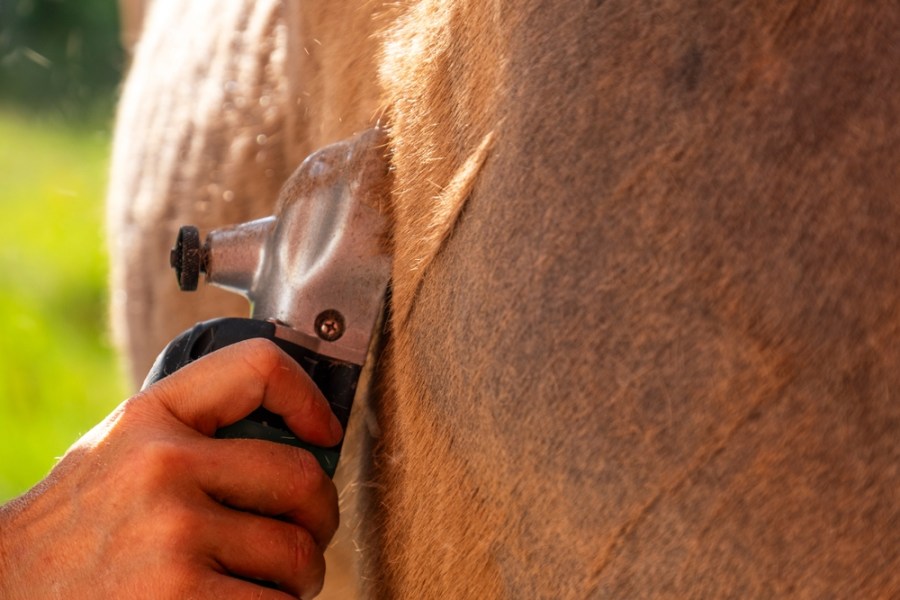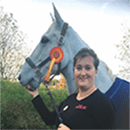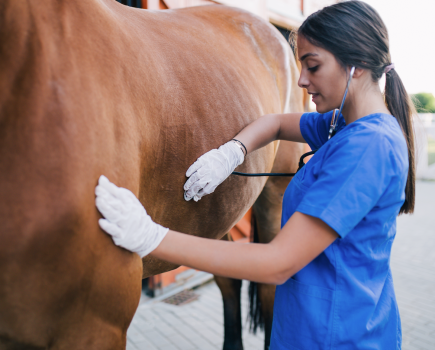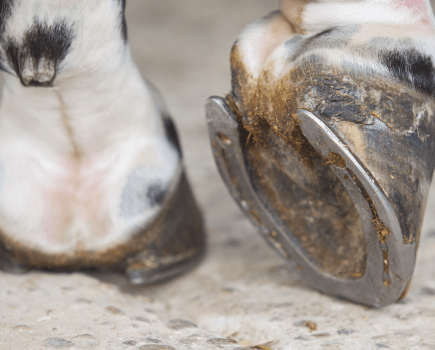Before you start clipping your horse, think carefully about how much hair you need to remove. Take your horse’s workload, lifestyle and age into consideration – can you keep them well-rugged and warm enough if you clip out their body completely, or would a partial trim where they sweat most frequently be sufficient?
As a general rule, horses continuing to do a lot of work during the cold months and who are stabled at night suit having more hair removed compared to a horse in lighter work or one who will be turned out at night.
Use the following guide to decide which type of clip would suit your horse best. In the diagrams, the shaded areas on the horse show where the hair needs to be removed for that particular type of clip.
Neck and belly (bib) clip
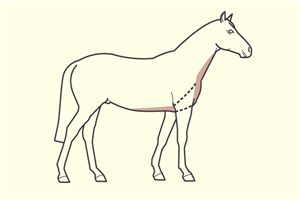
A bib clip is an underside trim which is ideal for any horses in light work who are turned out all through the winter. This is a popular clip because it is simple to do. Any mistakes or uneven lines aren’t obvious and it still leaves your horse with plenty of coat on their body.
This clip is also called the ‘sweat clip’, as it takes off hair only where the horse sweats most. You can also remove hair over the tops of the front legs.
How to do a neck/ belly (bib) clip
- Chalk your guidelines. For the stomach, take a line from the elbows, horizontally back to the stifles.
- If the horse is wary, stroke along the stomach with your hand in long, firm strokes first.
- Don’t be too light with your clippers as it tickles the horse more, possibly causing them to flinch or fidget. A firm, flat hold against the horse is best.
How to clip around the elbow
- Have a helper lift the horse’s foreleg and pull it forwards to make the area you’re clipping flatter and firmer.
- Pull any loose skin taut so that you don’t nick it with the clipper blades. Be careful and avoid your fingers with the clipper blades too.
- Follow the horse’s muscle that runs diagonally along the top of the foreleg to get a neat angle.
Top tip
A horse’s winter coat provides protection from the elements, so if you clip any hair, rug up accordingly to keep them warm – especially if they are spending time in the field.
Remember, too, that the horse will be pretty fresh to ride on a frosty morning if you remove all their winter woollies, because they’re cold!
Trace/chaser clip (low or high)
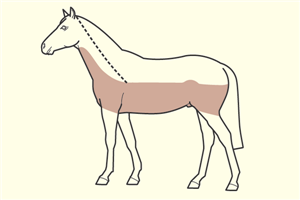
A trace clip is suitable for a horse in light or medium work. A higher trace can include the whole or part of the head, which is also called a chaser clip (see dotted line on diagram, above).
Named after the traces of a carriage, the trace clip follows straight horizontal lines along the horse’s body.
Trace clips can be low, medium or high, according to how much hair you want to take off.
A high trace clip also takes off hair from the horse’s head. High trace clips give the illusion of making the legs appear longer on a short-legged horse.
How to do a trace clip
- For a low trace clip, take a line around 7in below where your saddle flap lies.
- For a medium trace clip, use the bottom of the saddle flap as a guide.
- For a high trace clip, take a line about 5in above the bottom of the saddle flap.
- Add chalk lines that are straight and symmetrical on each side, especially over the back of the hindquarters. Stand back from the horse so that you can see both sides at the same time to check their symmetry.
- To neaten a horizontal line, turn the clippers side on so that the blades clip neatly across the jagged edge.
- For a chaser clip, take a line from behind the horse’s shoulder up to just behind their ears. This means more neck hair comes off, plus the head.
Hunter clip
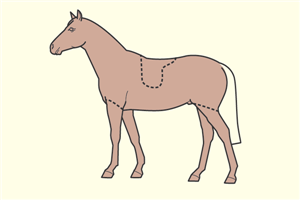
A hunter clip is suitable for a horse in medium to hard work. The legs and saddle area are left on for protection (see dotted lines on diagram, above). For a full clip, these areas can be removed completely.
The hunter clip is a variation of the full clip, but with leg and saddle patch hair. It’s good for horses who work hard but are likely to pick up thorns, knocks and cuts out hacking or hunting. Leaving the hair over the saddle patch also helps keep sweat away from the skin, and leaves the body less prone to rubbing.
For a full clip, the whole coat is taken off. It can be used as a first clip and swapped for a different one later in the year. Take care to keep horses with a full clip warm, especially at night.
How to do a hunter clip
- For a hunter clip, mark neat diagonal guidelines on the tops of the horse’s front and hind legs.
- Place their saddle (including saddlepad underneath) on the horse and draw an outline around it, with a 2in margin.
- Clip all other hair off, apart from the legs and saddle patch.
How to do a full clip
- For a full clip, take off all body hair, including legs and face.
- When clipping the inside of the hind legs, move the tail out of the way and clip from the opposite side. You could also plait the tail and tie it up to keep it out of the way.
- Leave a neat upside down ‘V’ of unclipped hair at the top of your horse’s tail. Take a point from about 6in each side of the tail and clip a line towards the spine, until both sides meet.
Top tip
Hunter and full clips are really only necessary for horses in hard, regular work. For other horses, a blanket, trace or bib clip will usually suffice.
Blanket clip
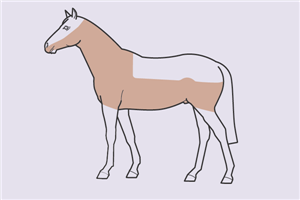
A blanket clip leaves a blanket-shaped patch of hair over the horse’s back, from withers to tail. It provides warmth and protection from the weather.
A blanket clip removes enough hair from the horse’s stomach and all of the neck, plus the legs, to ensure efficient cooling during and after hard exercise.
This type of horse clip is good for horses in medium to hard work. You may need to provide a rug with a neck cover with this clip, especially overnight and when turned out in winter.
Blanket clips give the impression of your horse’s back being shorter and so can flatter a long-backed horse.
How to do a blanket clip
- When chalking clipping lines, be guided by your saddle and where it sits.
- The front edge of your blanket should sit just in front of the saddle.
- The bottom edge should be in line with your saddle flaps or a little higher, so that the front of the blanket can’t be seen when the horse is ridden.
- Take off the hair on the neck, chest, stomach, and hindlegs, clipping up to the bottom of the blanket.
- You can choose to clip a half head (cheek only) or the full head.
- To achieve an even blanket clip on both sides, stand several feet in front of your horse so that you can see the line on both sides.
- Repeat this at the back too.
- Make sure the clip on the hindlegs match when looking at them from behind – you’ll need to lift the tail to check this.
- The blanket lines should meet each other at the same point under the tail too.
- All neck hair needs to be removed. To do this, brush the mane over to the other side and clip up to 1cm below the roots of their mane.
- Repeat on the other side. Don’t clip too close to the mane as it will result in messy regrowth. You really need a horse to be still while doing this area, so a handler may be wise!
Clipping a horse’s head
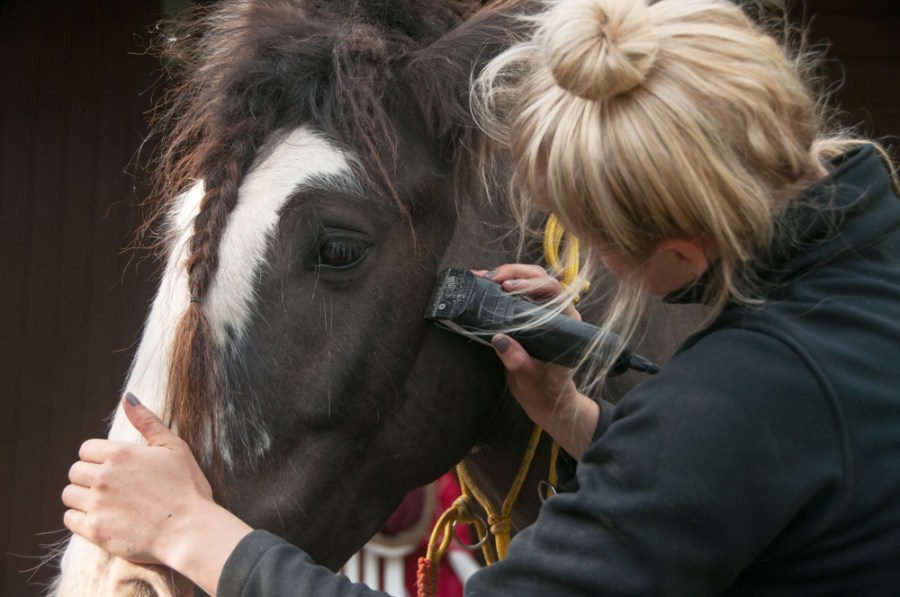
When it comes to clipping a horse’s head, there are several options.
Full head
For those in hard work and with a hunter or full clip, a full clip of the head is often the preferred choice. However, a half-head is also acceptable and smart, especially in horses nervous about being clipped.
Some are happy to be clipped on their body but unsure about their head being touched with clippers, which is understandable when you think about it!
When all the head and face hair is removed, you will need a small set of clippers in order to get close to the ears and around the ears. Smaller often means quieter too, which is a good idea when doing the head.
Always make sure you leave the whiskers on. These shouldn’t be clipped off.
Half head (pictured above)
This is a popular choice with all types of clip that also remove all or most of the neck hair.
It is my personal preference when clipping my own horses because it is smart and less fiddly to do than a full head. Keeping the hair on the front of their face helps keep them warmer in winter too, especially when out in the field.
For a half head, clip in a straight line from the base of the back of the horse’s ear down to the top of the mouth. It’s roughly where the cheekpiece sits when wearing a bridle.
Remember to do the back of the head too. This is usually the fluffiest bit!
Back of head
If you have chosen a trace or bib clip, you may opt to remove the hair at the very back of the horse’s head too.
Images © Shutterstock

